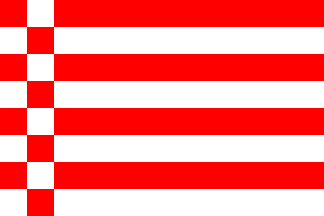Originally posted by Mojotronica
Gael --
What're the stories behind the other provincial flags in the middle pic? What are the provinces?
On your request Mojo:
Munster:
Three gold crowns on a blue field were the arms of Ireland before the adoption of the harp in the 16th century. The symbolism of the crowns on the Munster flag is not certain, but one possibility is that they may represent the three most important medieval lordships in the province, the O'Briens (Thomond), the Butlers (Ormond) and of the Fitzgeralds (Desmond).
Traditional history of Ireland speaks of five waves of invaders. One of these is supposed to have come from Scythia under the leadership of Miled, or Milesius, and his eight sons, of whom five died in the conquest of the island, and the surviving three shared the kingship. There is a reference to "the oldest flag that ever sailed the sea, three crowns on a field of blue, for the three sons of Milesius."
Connacht:
The origin of the two elements displayed on the arms and flag of Connacht is obscure, even being traced to the Schottenkloster or Irish monastery founded in Regensburg, Bavaria in the 11th century, but it is likely that the arm and sword derive from the arms of the O'Connors, the ruling family in the province before the Norman invasion, and that the black eagle derives from the arms of the Browns, one of the 'tribes' of Galway city. If this derivation is correct, the flag would be a symbol of the 17th-century unity of Gaels and Old English.
Leinster:
The Green Flag was the unofficial national flag from 1798 until the early years of the 20th century. A gold harp on a blue field was the arms of Ireland since the 16th century, but the United Irishmen changed the colour of the field from blue to green, the colour that symbolised revolution in the late 18th century. Leaves, branches and liberty trees were frequently employed as republican emblems at the time.
The Green Flag quickly won popular acceptance as the national flag of Ireland. It was used by the followers of Daniel O'Connell, by the Fenians (for the most part), and by the supporters of Home Rule from the time of Parnell until the collapse of the Irish Parliamentary Party in 1918. Popular rejection of the flag at that point can be partly attributed to its use by the British army in recruitment campaigns during the First World War.
Both the Green Flag and the tricolour were used by the insurgents in 1916, but in the period after the rebellion the republican separatists in Sinn Féin tended to use the tricolour while their rivals in the Irish Parliamentary Party (which advocated 'Home Rule' for Ireland within the United Kingdom) used the Green Flag exclusively. The alternative national flags thus became the flags of competing political parties until the general election of December 1918 when Sinn Féin's landslide victory finally relegated the Green Flag to a secondary role.
A bit more than you asked for maybe.

















 When did that happen?
When did that happen?